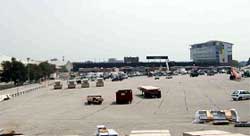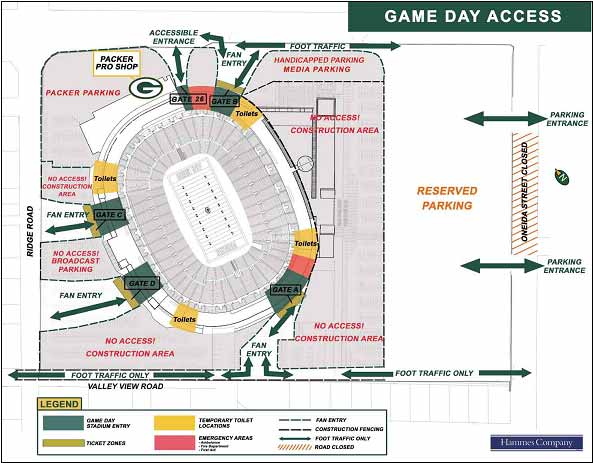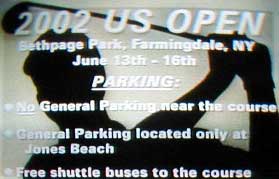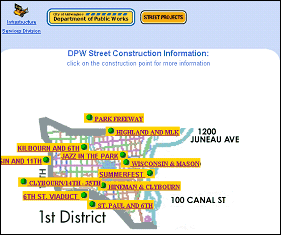
Managing Travel for Planned Special Events
Chapter Five. Event Operations
Planning
Page 4 of 4
External Factors Affecting Scope of Event Impact 
Overview
This chapter summarizes event operations planning and impact analysis activities that address the core factors affecting planned special event severity. That is, travel demand, road/site capacity, and event operation. A number of secondary factors warrant consideration in the event operations phase, including:
- Available resources
- Weather
- Concurrent roadway construction
- Concurrent planned special events
These factors can greatly influence the level of impact a planned special event has on transportation system operations. By gaining an understanding of the special challenges that these external factors present, the event planning team can develop appropriate contingency response plans, using the tools and strategies presented in Chapters 6 and 7, to mitigate infrequent but high-impact scenarios.
An assessment of the level of impact that an external factor has on travel during a particular planned special event involves the consideration of the following components:
- Duration – temporal impact (e.g., when does the external factor impact operations and for how long?).
- Extent – spatial impact or scope of area affected (e.g., does the external factor impact a particular corridor or the entire region?)
- Intensity – volume of impact (e.g., how severe is the impact?)
Practitioners should express the impact of an external factor in terms of how it affects travel demand, road/site capacity, and personnel/equipment resource quantities. Feasibility study input data can reflect adjustments made due to certain anticipated external factors, or practitioners can rerun parking and roadway capacity analyses to account for a new unexpected factor (e.g., occurrence of emergency road construction). In turn, revised results may warrant adjustments to the event traffic management plan.
Available Resources

Figure 5-15. Stadium Reconstruction
Available resources refer to the quantity and experience of personnel and equipment available to plan and conduct day-of-event travel management operations. Besides the size of a planned special event, the level of required resources depend on time/place of occurrence, other planned special events, and equipment status.
A special factor that may place significant strain on available resources involves the occurrence of planned special events at a venue under reconstruction. Shown in Figure 5-15, venue reconstruction places additional demand on the amount of traffic management team personnel and equipment resources needed to manage events hosted by the venue during its reconstruction. Stakeholder response to on-site parking restrictions include redevelopment of traffic management plans to accommodate parking demand, pedestrian access, and traffic flow in the immediate vicinity of the venue.
Figure 5-16 presents a site and pedestrian accommodation plan for 2002 Green Bay Packers games during Lambeau Field renovation. Appendix F contains contingency parking and pedestrian accommodation plans for event patrons traveling to Lambeau Field.

Figure 5-16. Site and Pedestrian Accommodation Plan for Stadium Reconstruction
Weather

Figure 5-17. Contingency Parking Plan for Weather
Weather conditions affect travel demand, road/site capacity, or both. For example, in winter, snow banks in permanent venue parking areas reduce the number of on-site parking spaces required for an event sell-out. Rain can create significant problems for unpaved parking areas and access roads. A one-day rain event totaling approximately 0.70 inches during the 2002 U.S. Golf Open forced the traffic management team to close all unpaved parking areas adjacent to the golf course. Figure 5-17 displays a traffic advisory service television announcement issued to indicate contingency parking arrangements that used paved lots.
With regard to travel demand, weather conditions have a significant impact on attendance (e.g., increased attendance or reduced attendance) and/or the rate of arrivals and departures at some special events. For instance, event patrons will attend an event at a domed stadium on a rainy day, but patrons will bypass arriving at the venue early to tailgate, thus concentrating patron arrivals.
Concurrent Road Construction and Planned Special Events
The occurrence of planned events, including road construction and other planned special events, create a range of impacts affecting different traffic management plan components. On a regional level, the characteristics (e.g., increased traffic demand, road/lane closures) of concurrent planned events reduce available capacity in roadway corridors serving a particular planned special event, thus affecting traffic flow patterns. Local impacts include reduced parking supply, in the event of other area planned special events, and restricted traffic circulation.
The identification of concurrent planned events requires interagency communication at the local, county, and state level. Figure 5-18 illustrates an example of a local department of public works (DPW) inventory, accessible through the DPW website, of active local road construction and other planned special events within the jurisdiction.

Figure 5-18. Internet Summary of Road Construction and Planned Special Events (Graphic courtesy of the City of Milwaukee DPW.)
Key considerations include:
- With regard to planning for a specific planned special event, the event planning team should identify road construction activities in all jurisdictions within a certain travel time or distance radius, equivalent to the event market area, of the event venue. Appendix G contains a local stakeholder outreach letter pre pared by the Wisconsin DOT to identify local road construction in the vicinity of Miller Park and scheduled during the 2002 All-Star baseball game.
- The event planning team must also interact with area venue operators and determine a timeline of planned special events in the region, particularly those affecting the transportation system serving the subject planned special event.
- Recognizing the regional impacts (e.g., county and multi-county) of major planned special events, the event planning team should obtain information, including attendance estimates, on planned special events occurring in other metropolitan areas and areas with large venues within a certain radius (e.g., 50 or 100 miles). Highway corridors traversing one jurisdiction can realize a significant increase in background traffic during typical off-peak periods as a result of traffic generated by major events occurring in other jurisdictions.
External Factor Monitoring and Assessment
The event planning team should maintain, and continually update, a spreadsheet matrix or map of inter-jurisdictional roadway construction and planned special events occurring over some defined period of time. For example, Appendix G contains a Wisconsin DOT summary of local and state road construction coupled with major planned special events occurring in the Milwaukee metropolitan area over Summer 2002. Identification of concurrent planned events allows stakeholders to merge transportation planning and operations efforts and consider revising road construction schedules.
On a broader scale, a regional committee on planned special events monitors planned events across a metropolitan area through regular meetings with traffic operations agencies, law enforcement, community officials, event organizers, and other agencies. The committee facilitates communication and coordination between specific event planning and operation task forces to ensure optimal application of personnel and equipment resources. The Traffic Incident Management Enhancement (TIME) program in southeastern Wisconsin maintains such a committee. As highlighted in Chapter 2, the TIME special event committee proposed development of a traffic management planning tool designed to evaluate the severity level of any planned special event proposed in the greater Milwaukee metropolitan area. Table 5-19 lists specific external factors, and associated criteria, accounted for in the draft planning tool.
| Question: What is the effect of construction on traffic? | Criteria | Criteria | Criteria | Criteria | Criteria |
|---|---|---|---|---|---|
| Is there a construction project on any of the corridors leading to or away from the special event venue? | Not applicable | Some impact | Moderate impact | Considerable impact | Severe impact |
| Are there any lane closures? | Not applicable | Some impact | Moderate impact | Considerable impact | Severe impact |
| Question: What effect does the event scheduling have on traffic? | Criteria | Criteria | Criteria | Criteria | Criteria |
|---|---|---|---|---|---|
| Is the event scheduled to begin or end during a peak period? | Not applicable | Some impact | Moderate impact | Considerable impact | Severe impact |
| Is there more than one event beginning or ending at the same time? | Not applicable | Some impact | Moderate impact | Considerable impact | Severe impact |
| Question: What are the weather conditions? | Criteria | Criteria | Criteria | Criteria | Criteria |
|---|---|---|---|---|---|
| Is there a forecast for severe weather before, during, or after the special event that might affect traffic? | Clear | Mild | Moderate | Severe-summer | Severe-winter |
| Question: Are all human resources available? | Criteria | Criteria | Criteria | Criteria | Criteria |
|---|---|---|---|---|---|
| Is the event scheduled to begin and end during normal working hours? | Yes | Most | Some | Few | None |
| Are key individuals available if needed? | Yes | Most | Some | Few | None |
| Question: Is all equipment available? | Criteria | Criteria | Criteria | Criteria | Criteria |
|---|---|---|---|---|---|
| Are all facilities available? | Yes | Most | Some | Little | None |
| Is communication equipment working? | Yes | Most | Some | Little | None |
| Is all traffic control equipment available? | Yes | Most | Some | Little | None |
References
1. Held, T., "Dead Family Reunion in East Troy Is a Go," Milwaukee Journal-Sentinel, June 28, 2002.
2. Schmitt, B., "State Troopers Close Roads into Downtown Detroit," Detroit Free Press, June 13, 2002.
3. Laitner, B., "Royal Oak Preparing to Handle Crowds of Red Wings Fans," Detroit Free Press, June 13, 2002.
4. "Hundreds questioned in Nevada Casino Deaths," CNN.com, April 28, 2002.
5. Shaw, T., Performance Measures of Operational Effectiveness for Highway Segments and Systems, NCHRP Synthesis 311, Transportation Research Board, National Research Council, Washington D.C., 2003, 59 pp.
6. Markley, D.D., N.L. Conrad, and G.S. Rutherford, "Serving the University of Washington's Husky Stadium," Preprint No. 00113, Prepared for the 2001 ITE Annual Meeting and Exhibit, Institute of Transportation Engineers, Chicago, Illinois, August 19–22, 2002.
7. Rankin, E.A., "A Home Run or Out in Left Field? Transportation Management for the New Seattle Mariner's Baseball Park," Prepared for the ITE 1998 Annual Meeting and Exhibit, Institute of Transportation Engineers, Toronto, Ontario, Canada, 1998.
8. "2003 U.S. Cellular Field Resident Permit Parking Program", Chicago Department of Transportation, Chicago, Illinois, [Online]. Available: http://www.ci.chi.il.us/Transportation/Sox/. [2003, April 25].
9. Joint Operational Policy Statement, Illinois Department of Transportation and Illinois State Police, February 1999.
10. A Joint Operations Policy Statement, Washington State Patrol and Washington State Department of Transportation, Washington, February 2002.
11. Wrenn, D., "Turnpike Letting Drivers Go Free in Heavy Traffic," Charleston Daily Mail, December 4, 2002.
12. Townsend, E., "Freshman Delegate Wants Bridge Tolls Stopped in Backups," The Star Democrat, February 10, 2003.
13. "Wrecker and Towing Rules and Regulations for Police Rotation Wreckers," City of Cincinnati Municipal Code Section 869.21.
14. Robbins, G., A. Felder, and W.E. Hurrell, "San Francisco's New Downtown Ballpark: A Home Run for Public Transit," Preprint No. 00111, Prepared for the 2001 ITE Annual Meeting and Exhibit, Institute of Transportation Engineers, Chicago, Il., August 19–22, 2001.
15. Grava, S. and F. Nangle, "Get Me to the Ball Game on Time – Access Time Patterns at Baseball Stadia," Preprint No. 00395, Prepared for the 2000 Annual Meeting of the Transportation Research Board, National Research Council, Washington, D.C., January 9–13, 2000.
16. Peterson, M., D.M. Marum, and A. Moran, "Mode of Access for the New Downtown San Diego Ballpark," Prepared for the ITE 2000 Annual Meeting and Exhibit, Institute of Transportation Engineers, San Diego, Ca., 2000.
17. Traffic Considerations for Special Events, Institute of Transportation Engineers, Washington, D.C., 1976, 44 pp.
18. Montag, D.A., Trip Generation Rates and Characteristics for Theme-Oriented Fairs and Festivals, West Virginia University, Morgantown, West Virginia, May 1998.
19. Parking and Traffic Management Plans for Investco Field at Mile High, Prepared for the City and County of Denver by Turner/HNTB, June 2002.
20. Volz, M.A. and B.J. Nicholson, "Kansas Speedway Event Management Using ITS," n.d.
21. Womble, J.E., "A Transportation and Tourism Profile of Visitors to the 1984 Louisiana World Exposition in New Orleans," ITE Journal, Vol. 55, No. 4, April 1985, pp. 49–53.
22. Boggs, R., "Challenges in Supporting Planned Special Events in Your Community," Presented at the Institute of Transportation Engineers 2003 Technical Conference and Exhibit Program," Fort Lauderdale, Florida, March 23–26, 2003.
23. Shell Grand Prix of Denver – Parking and Traffic Management Plan, Prepared for the Grand Prix of Denver by URS Corporation, August 2002, 33 pp.
24. Sattayhatewa, P. and R.L. Smith, "Development of Parking Choice Models for Special Events," Presented at the 82nd Annual Meeting of the Transportation Research Board, Washington, D.C., January 12–16, 2003.
25. Silverson, S., Wisconsin Department of Transportation – District 2, Personal Communication, February 18, 2003.
Planned Special Events Traffic Management | Privacy Policy